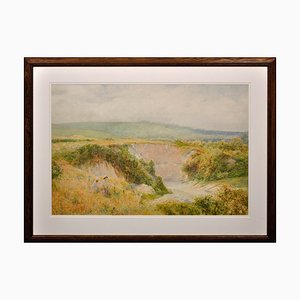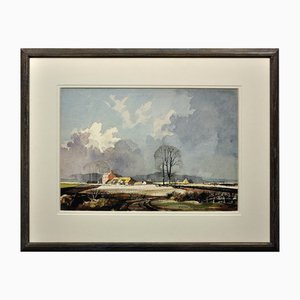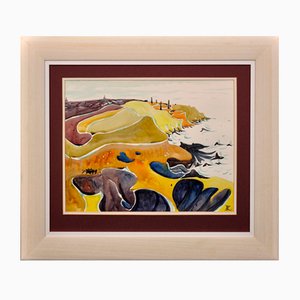Frederick Lee Bridell.
English ( b.1831 – d.1863 ).
Portland Roads and Sandsfoot Castle from Weymouth, 1856.
Watercolour, Bodycolour, Pen & Ink On Paper.
Signed & Dated Lower Left.
Image size 6.3 inches x 10.4 inches ( 16cm x 26.5cm ).
Frame size 15.4 inches x 19.7 inches ( 39cm x 50cm ).
This original watercolour is by Frederick Lee Bridell and is dated 1856.
The painting is presented and supplied in a sympathetic contemporary replacement frame (which is shown in these photographs), mounted using new conservation materials and behind non-reflective Tru Vue UltraVue® UV70 glass.
This antique painting is in good condition, defying its age. It is supplied ready to hang and display.
The watercolour is signed and dated lower left.
Frederick Lee Bridell was a popular and talented artist in nineteenth century Britain. He was born at Southampton in 1831, the third child and only son of John Bridell, a carpenter and his wife Amelia. Frederick received only a rudimentary education and was obliged by family circumstances to leave school early in order to earn a living. According to contemporary sources however, he had been drawing and writing verse from the age of 9. At 15 he was working in his native town as a portrait painter and made the acquaintance of Henry Rose, later a printer and engraver in Southampton, who encouraged his obvious talent His portrait of Henry Rose attracted the notice of art restorer and picture dealer, Edwin Holder, who subsequently employed him on a five-year apprenticeship to reproduce portraits. Holder also allowed Bridell to reside with him and his family near Bray in Berkshire, and later funded his art education abroad.
After a short period in Paris, where he copied works in the Louvre, Bridell established himself in Munich. Here he became influenced by the Dutch school, copying works by Cuyp, Van der Velde and Berchem. He started producing wonderful landscapes, which were his preference.
Between 1853 and 1855 Bridell travelled extensively in Europe. He had a short period in Paris, where he copied works in the Louvre, then established himself in Munich where he became influenced by the Dutch school, copying works by Cuyp, Van der Velde and Berchem. He then went to Austria where he was inspired by the mountainous landscapes of the Tyrol. Having learnt the techniques of the great masters by copying their work, he returned to England and completed his own landscape works from sketches made on his travels. He also painted portraits of wealthy Southampton residents.
Between 1853 and 1855 he travelled in France, Germany and Austria where he was inspired by the mountainous landscapes of the Tyrol. On returning to England he completed works from sketches made on his European travels and painted a number of portraits of wealthy Southampton inhabitants.
By 1858 Bridell had acquired a new patron, James Woolff, a shipping magnate of Bevois Mount. Woolff established a Bridell gallery at his home and allowed visitors to view the paintings. Bridell set up a new studio at Highfield Lodge, where he worked on the large painting ‘The Temple of Venus’.
Later in 1858, and now free from his financial constraints, Bridell travelled to Italy in and set up a studio in Rome, near the Spanish Steps. In Rome he met Eliza Florence Fox, the daughter of Mr. W.J. Fox, who was at that time the Member of Parliament for Oldham. They were both passionate about art and culture and after a whirlwind romance they married the following year. Eliza was well known to influential writers and thinkers of the time and Robert Browning ‘gave her away’ at the wedding ceremony. The newly wedded couple had their wedding breakfast at the Browning apartment in Bocca di Leon, where they were entertained by Elizabeth Barrett Browning.
Bridell’s new wife was herself a lady of much artistic talent and two days after they were married both were working in their respective studios. In1859, perhaps to mark their marriage, Eliza painted Bridell’s portrait.
During their short marriage Bridell’s output flourished, and he perfected his delicate yet powerful style. He completed and he exhibited his finest work ‘The Coliseum by Moonlight’, which was afterwards included in the International Exhibition of 1862. Today this is sometimes displayed in Southampton Art gallery. His other important paintings were ‘The Temple of Love’, often compared to the work of Turner, from Spenser’s ‘Fairie Queene’, and ‘Sunset on the Atlantic’.
Driven by his all-consuming desire to record the grand vistas before him, for a while he ignored the tuberculosis that was taking hold of his body. The couple travelled to the Lakes of Northern Italy in the hope that the cool mountain air would improve his condition, and he remained inspired and painted as much as he could.
Returning to England in 1863, he completed a painting of a very English scene of a graveyard overlooking the sea, perhaps recognising the inevitability of his approaching death. He died of consumption in Kensington in August of that year and was buried in Brompton Cemetery. He was only 32 years old and was outlived by both parents and a sister.
Bridell had exhibited at the Royal Academy, first sending his picture ‘A Bit of Berkshire’ in 1851, followed by ‘Mountains of the Tyrol’ in 1856. He also exhibited at the British Institute and other prominent galleries, but over his lifetime only a portion of his total output was exhibited.
In 1864 James Woolff, possibly for financial reasons, sold his collection of Bridell’s paintings through Christies. It was an impressive collection, which was never seen together again. Later, the Southampton businessman, William Borough Hill, an avid admirer of his work, bought many of Bridell’s paintings, including ‘The Colosseum in Rome by Moonlight’, which he had restored. In 1910 his art collection was acquired by Southampton Corporation. Hill named his house Bridell Lodge in honour of the artist.
Today, some of Bridell’s work is in the permanent collection at the Tate Gallery.
There is a bust of the artist on display in Tudor House, Southampton, created by the sculptor Richard Cockle Lucas in the nineteenth century.
This original watercolour painting with pen and ink detail is by English artist Frederick Bridell. It depicts a view from Weymouth, Dorset, in the mid nineteenth century. We look westwards down the coast, seeing Henry VIII’s Sandsfoot Castle on the cliffs to the right, and the Isle of Portland on the left. The thin strip of causeway and Chesil Beach, connecting Portland to the mainland can be seen on the horizon. There are figures on the shoreline path, and a couple of small fishing vessels on the sea. An arch of seagulls fly over the castle.
This work was completed in 1856, when the artist was at the height of his powers. It is a captivating and charming scene, capturing a moment in history, now long gone.




















Get in Touch
Make An Offer
We noticed you are new to Pamono!
Please accept the Terms & Conditions and Privacy Policy
Get in Touch
Make An Offer
Almost There!
To follow your conversation on the platform, please complete the registration. To proceed with your offer on the platform, please complete the registration.Successful
Thanks for your inquiry, someone from our team will be in touch shortly
If you are a Design Professional, please apply here to get the benefits of the Pamono Trade Program